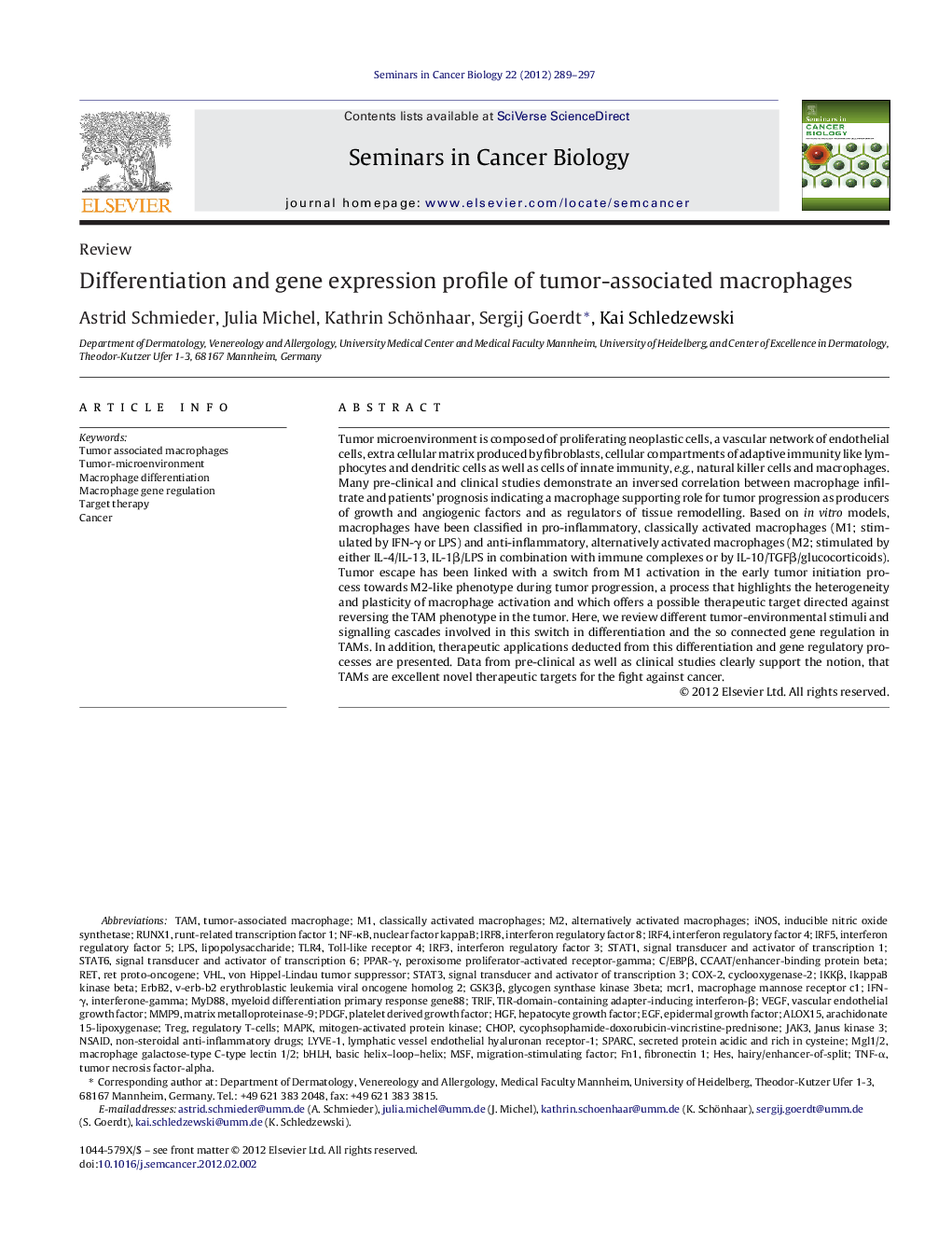| Article ID | Journal | Published Year | Pages | File Type |
|---|---|---|---|---|
| 10845655 | Seminars in Cancer Biology | 2012 | 9 Pages |
Abstract
Tumor microenvironment is composed of proliferating neoplastic cells, a vascular network of endothelial cells, extra cellular matrix produced by fibroblasts, cellular compartments of adaptive immunity like lymphocytes and dendritic cells as well as cells of innate immunity, e.g., natural killer cells and macrophages. Many pre-clinical and clinical studies demonstrate an inversed correlation between macrophage infiltrate and patients' prognosis indicating a macrophage supporting role for tumor progression as producers of growth and angiogenic factors and as regulators of tissue remodelling. Based on in vitro models, macrophages have been classified in pro-inflammatory, classically activated macrophages (M1; stimulated by IFN-γ or LPS) and anti-inflammatory, alternatively activated macrophages (M2; stimulated by either IL-4/IL-13, IL-1β/LPS in combination with immune complexes or by IL-10/TGFβ/glucocorticoids). Tumor escape has been linked with a switch from M1 activation in the early tumor initiation process towards M2-like phenotype during tumor progression, a process that highlights the heterogeneity and plasticity of macrophage activation and which offers a possible therapeutic target directed against reversing the TAM phenotype in the tumor. Here, we review different tumor-environmental stimuli and signalling cascades involved in this switch in differentiation and the so connected gene regulation in TAMs. In addition, therapeutic applications deducted from this differentiation and gene regulatory processes are presented. Data from pre-clinical as well as clinical studies clearly support the notion, that TAMs are excellent novel therapeutic targets for the fight against cancer.
Keywords
Janus kinase 3bHLHGSK3βPDGFTLR4TregVHLMMP9ALOX15Stat6HGFLYVE-1IRF3JAK3IRF4STAT3arachidonate 15-lipoxygenaseIRF8Runx1SPARCIKKβMSFFN1v-erb-b2 erythroblastic leukemia viral oncogene homolog 2CCAAT/enhancer-binding protein betaIRF5Lymphatic vessel endothelial hyaluronan receptor-1MCR1von Hippel-Lindau tumor suppressorPPAR-γERBB2MYD88LPSNSAIDCOX-2EGFiNOSNF-κBIFN-γc/ebpβMAPKRET proto-oncogeneStat1regulatory T-cellsTRIFbasic helix–loop–helixHESTIR-domain-containing adapter-inducing interferon-βTAMMacrophage differentiationTumor associated macrophagestumor necrosis factor-alphaCHOPRETNon-steroidal anti-inflammatory drugsCancerinducible nitric oxide synthetaseCyclooxygenase-2Interferon regulatory factor 3Interferon regulatory factor 4interferon regulatory factor 8epidermal growth factorHepatocyte growth factorrunt-related transcription factor 1interferon regulatory factor 5Vascular endothelial growth factorVascular Endothelial Growth Factor (VEGF)platelet derived growth factorTNF-αnuclear factor kappaBfibronectin 1lipopolysaccharideMatrix metalloproteinase-9Tumor-associated macrophageAlternatively activated macrophagesClassically activated macrophagessignal transducer and activator of transcription 1signal transducer and activator of transcription 3Signal transducer and activator of transcription 6Target therapyperoxisome proliferator-activated receptor-gammasecreted protein acidic and rich in cysteinemitogen-activated protein kinaseToll-like receptor 4
Related Topics
Life Sciences
Biochemistry, Genetics and Molecular Biology
Biochemistry
Authors
Astrid Schmieder, Julia Michel, Kathrin Schönhaar, Sergij Goerdt, Kai Schledzewski,
